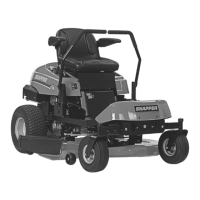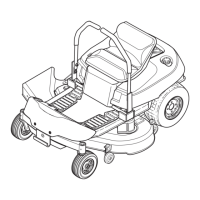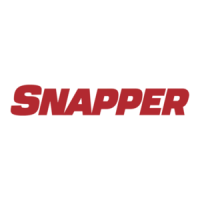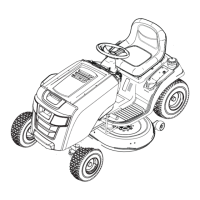16
Emergency Stopping
In the event of an emergency the engine can be
stopped by simply turning the ignition switch to STOP.
Use this method only in emergency situations. For
normal engine shut down follow the procedure given in
STOPPING THE RIDER AND ENGINE.
Stopping The Rider & Engine
1. Return the ground speed control levers to START/
PARK positions to stop rider movement.
2. Engage the parking brake.
3. Turn off the mower blades by pushing the mower
blade switch down to the OFF position.
4. Move the engine speed control to SLOW position and
turn the ignition switch to OFF. Remove the key.
Figure 2. Pre-Start Checks
A
Checks Before Starting
• Checkthatthecrankcaseoilisfilledtofullmark
on dipstick (see CHECK ENGINE OIL in the
Maintenance section).
• Fillthefueltankwithfreshfuel.
Fuel Recommendations
Fuel must meet these requirements:
• Clean,fresh,unleadedgasoline.
• Aminimumof87octane/87AKI(91RON).Forhigh
altitude use, see below.
• Gasolinewithupto10%ethanol(gasohol)isaccept-
able.
NOTICE: Do not use unapproved gasolines, such as E15
and E85. Do not mix oil in gasoline or modify the engine
to run on alternate fuels. Use of unapproved fuels will
damage the engine components and void the engine
warranty.
To protect the fuel system from gum formation, mix a
fuel stabilizer into the fuel. See Storage. All fuel is not the
same. If starting or performance problems occur, change
fuel providers or change brands. This engine is certified
to operate on gasoline. The emissions control system for
this engine is EM (Engine Modifications).
High Altitude
At altitudes over 5,000 feet (1524 meters), a minimum
85 octane/85 AKI (89 RON) gasoline is acceptable. To
remain emissions compliant, high altitude adjustment is
required. Operation without this adjustment will cause
decreased performance, increased fuel consumption,
and increased emissions. See a Briggs & Stratton Autho-
rized Dealer for high altitude adjustment information.
Operation of the engine at altitudes below 2,500 feet
(762 meters) with the high altitude adjustment is not
recommended.
To add fuel:
1. Remove the fuel cap (A, Figure 2).
2. Fill the tank to the bottom of the filler neck.
IMPORTANT: Do not overfill the fuel tank. Stop filling the
tank when fuel collects in the filler neck.
3. Install and hand tighten the fuel cap.
Operation
